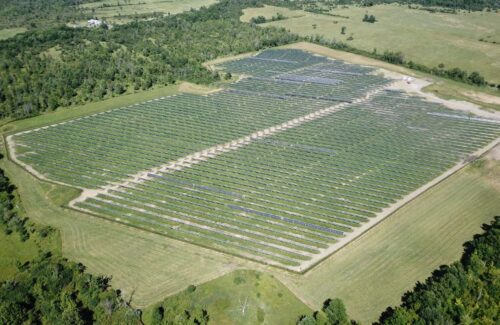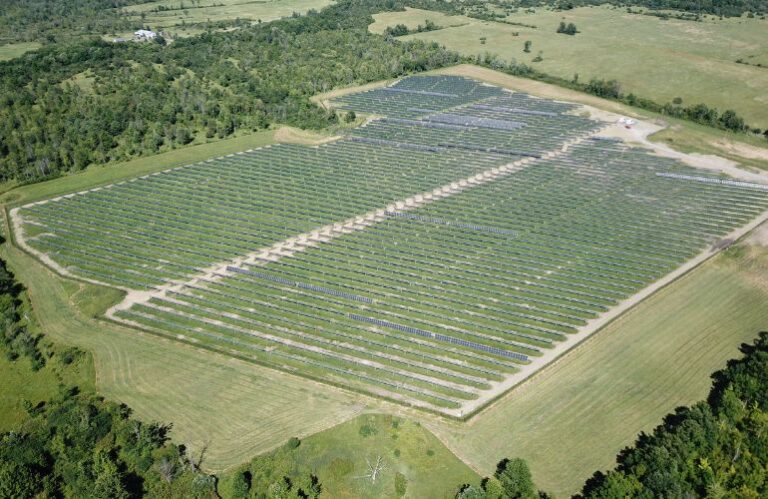
A community solar project by OYA Renewables in New York.
The New York Solar Energy Industries Association (NYSEIA) has “20 Gigawatts by 2035: Increasing New York’s Distributed Solar Goal (The Roadmap),” a detailed policy report that calls on New York State lawmakers, including Governor Kathy Hochul, to increase the state’s goal for distributed solar to 20 GW by 2035. Under New York’s current climate and energy transition plan, the state wants to install 10 gigawatts. by 2030.
The Roadmap outlines an action plan to double down on one of the bright spots in New York’s renewable energy transition: distributed solar. Distributed solar energy, consisting of rooftop installations on homes and businesses and small-scale ground projects in local communities, represents more than 90% of the state’s current solar capacity. New York added more than 800 MW of distributed solar capacity last year alone and is on track to surpass 6 GW by the end of 2024, a year ahead of schedule.
“As New York struggles to meet its ambitious renewable energy mandates, legislative leaders and regulators must take decisive action,” said Noah Ginsburg, executive director of NYSEIA. “Scale-up of distributed solar energy deployment will deliver cost-effective progress toward New York’s overall climate goals while delivering tremendous benefits to New York’s environment, economy and working families.”
CLCPA setbacks
In 2019, New York passed the Climate Leadership and Community Protection Act (CLCPA), widely considered one of the most ambitious statewide renewable energy mandates, directing New York to achieve 70% renewable energy by 2030 renewable energy and 100% renewable energy by 2040. and a carbon neutral economy by 2050.
Since then, a wave of high-profile cancellations of renewable energy projects has threatened the feasibility of reaching 70% renewable energy by 2030. In 2023, Governor Hochul implemented a 10-point action plan to get utility-scale sustainable projects back on track. . These utility-scale projects are important, but not sufficient to meet New York’s mandates; New York must more than double its renewable energy generation by 2030 to comply with the CLCPA, and rapid deployment of rooftop and community solar can fill this gap.
Ambitious but feasible solar growth
As The Roadmap outlines, solar deployment in New York has grown rapidly over the past decade, with an average annual growth rate of 31% between 2013 and 2022. This rapid growth was driven by New York’s industry-leading solar program. New York faces new challenges in deploying rooftop and community solar, but to reach 20 GW of distributed solar by 2035, the state will need only 7 to 10% annual growth in deployment to persevere. This growth can be made possible by smart policies at the state level and fueled by federal stimulus available over the next decade thanks to the Inflation Reduction Act.
“Distributed solar has performed so well in New York because it fits the nature of our state,” said Senator Pete Harckham, chairman of the Environmental Conservation Committee. “We have a unique mix of urban, suburban and rural communities that can support a diverse portfolio of renewable energy projects, and it is time we strengthen our character as a state. Distributed solar energy is essential to a sustainable future for the millions of consumers and businesses that want to be part of the climate solution.”
Meaningful benefits for New Yorkers
Deploying 20 gigawatts of distributed solar energy by 2035 will provide New Yorkers with: $50 billion in gross electric bill savings; $3 to 4 billion in revenue for rural landowners, municipalities and school districts; and support an additional 15,000 good jobs in the solar energy sector. In low-income communities, where New Yorkers face disproportionately high energy costs and pollution levels, these benefits are especially powerful. Distributed solar energy is an effective way to deliver benefits to New Yorkers who need them most and meet the CLCPA requirement that 40% of clean energy benefits accrue to underserved communities.
Policy interventions with a major impact are needed
New York will not reach 20X35 with a “business as usual” approach. The roadmap outlines the policy reforms needed to realize the potential of distributed solar energy, including:
- Interconnection reform and flexible interconnection to reduce clean energy costs and accelerate deployment
- Streamlined permitting for rooftop and community solar
- Virtual power plant programs and dynamic rate design to offset distributed solar and energy storage to export power where and when needed
- Continued investments in New York’s leading solar programs to deliver even more direct cost savings for low-income New Yorkers
To learn more about NYSEIA’s plan to double New York’s distributed solar deployment and the benefits it will bring to the state, view the full roadmap. here.
News release from the New York Solar Energy Industries Association


